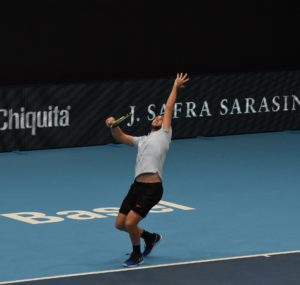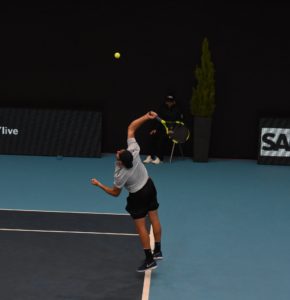Jack Sock – Service 3.0

Nebraska-born Jack Sock (*92 / USA) came, after his rather difficult Summer of 2017, which was highlighted solely by his semifinal appearance at the Citi Open in Washington, to the top form at the end of the year when he captured with the 2017 Paris Masters his biggest title yet. This win (together with Jack’s great results in the first 3 months of the year 2017) catapulted him into the ATP top 10 for the first time and secured him also his premier ATP Masters qualification. Needless to say, the almost weird mass absence of players like Novak Djokovic, Andy Murray, Kei Nishikori, Stan Wawrinka, Milos Raonic, Tomas Berdych as some others was surely helpful for Jack, but achieved is achieved… and the history mostly forgets circumstances…
From my point of view, the cooperation with his new personal coach Jay Berger, which began just a few months ago, is starting to bear fruits. As it seems to me, they partly cleaned up Jack’s forehand, which started to get on the backswing part of it rather a bit over-complicated and thus partly vulnerable (more about Jack’s forehand in my previous article here), they also made some improvements on Jack’s backhand as well as on backhand return and then some serious work has been done on Jack’s service, which can be considered as quite a weapon now. In this article, I would like to focus on some qualities of this “new Sock service”, as he showed them at the ATP 500 tournament in Basel (SUI) a few weeks ago already, just before the above mentioned Paris event. The photos below are from Jack’s match against Robin Haase (NED) during Basel’s Swiss Indoors. His services clicked speeds over 200 km/h = 125mph quite often in this match.
As can be seen in the photo rows below, Jack has mastered the skill of the body energy unloading against the target going over the optimal form of the”targeted pronation”, which is then the typical sign of the greatest servers. In the comments below, I am mentioning some of the details from the Tennis 3.0 Code for the Service 3.0, which help accomplish this task. At present, I see the biggest weakness of Jack’s service in his rather unstable toss, which has some subtle but important stabilization elements missing. It is mainly in the cases of the “out of the sync” tossing (left) arm motion when his unloading qualities can’t be fully played out.

Jack Sock (*92 / USA) – 1st service 3.0 in a match warm-up – 1 of 6 – end of the toss combined with significant loading already, tossing (left) arm going back after the ball release is a certain risk factor – 2017 Swiss Indoors – Basel / Switzerland

Jack Sock (*92 / USA) – 1st service 3.0 in a match warm-up – 2 of 6 – transfer from the platform to the pinpoint stance in the stage of practically full leg loading – 2017 Swiss Indoors – Basel / Switzerland

Jack Sock (*92 / USA) – 1st service 3.0 in a match warm-up – 3 of 6 – beginning of the unloading in the lower body with a perfect eye control of the tossed ball – 2017 Swiss Indoors – Basel / Switzerland

Jack Sock (*92 / USA) – 1st service 3.0 in a match warm-up – 4 of 6 – end of the push-off, both feet left the ground, good control of the body axis and head stability, excellent high elbow position while coming out of the cocking position – 2017 Swiss Indoors – Basel / Switzerland

Jack Sock (*92 / USA) – 1st service 3.0 in a match warm-up – 5 of 6 – follow through 1 = targeted pronation with a good body energy unloading, which is being made possible also thanks to good control of the left arm/shoulder – 2017 Swiss Indoors – Basel / Switzerland

Jack Sock (*92 / USA) – 1st service 3.0 in a match warm-up – 6 of 6 – follow through 2 = relaxation – as practically the entire energy was spent against the target, racket doesn’t travel far and makes early preparation for the next stroke possible – 2017 Swiss Indoors – Basel / Switzerland

Jack Sock (*92 / USA) – 1st service 3.0 in a match – 1 of 3 – end of the toss – still a bit erratic (mainly after the ball release) and sometimes not best controlled – rather an extreme platform starting position and loopy path of the tossing arm after the ball release might be the reasons – 2017 Swiss Indoors – Basel / Switzerland

Jack Sock (*92 / USA) – 1st service 3.0 in a match – 2 of 3 – explosive upward motion from the cocking position towards the impact – excellent eye control, well-controlled body axis as well as racket and arm axis – 2017 Swiss Indoors – Basel / Switzerland

Jack Sock (*92 / USA) – 1st service 3.0 in a match – 3 of 3 – end of follow through 1 = targeted pronation with perfect unloading of the body energy into the stroke (aka long-axis pronation), the dominant (right) hip is high and far in the court, optimal left arm/shoulder stopping ads to the efficiency of the unloading – 2017 Swiss Indoors – Basel / Switzerland

Jack Sock (*92 / USA) – 1st service 3.0 in a match – 1 of 5 – end of the toss, the feet came from the platform to the pinpoint stance already/ loading at its deepest – 2017 Swiss Indoors – Basel / Switzerland

Jack Sock (*92 / USA) – 1st service 3.0 in a match – 2 of 5 – start of the push-off – racket travels into the cocking position, perfect control of the tossing arm in this sequence of the stroke – 2017 Swiss Indoors – Basel / Switzerland

Jack Sock (*92 / USA) – 1st service 3.0 in a match – 3 of 5 – end of the push-off – both feet left the ground, eyes control the tossed ball, racket is well in line with the intended target, right hip is coming up and forward – 2017 Swiss Indoors – Basel / Switzerland

Jack Sock (*92 / USA) – 1st service 3.0 in a match – 4 of 5 – end of follow through 1 = targeted pronation – most of the energy was unloaded against the target, shoulder axis is well-controlled and the short-term blocking of the left shoulder was helpful in the optimal energy unloading – 2017 Swiss Indoors – Basel / Switzerland

Jack Sock (*92 / USA) – 1st service 3.0 in a match – 5 of 5 – follow through 2 = relaxation / well-balanced landing far in the court – practically the entire energy was spent in the direction of the intended target – 2017 Swiss Indoors – Basel / Switzerland

Jack Sock (*92 / USA) – 1st service 3.0 in a match – 1 of 4 – toss with high and well-controlled ball release, racket take-back is only starting – 2017 Swiss Indoors – Basel / Switzerland

Jack Sock (*92 / USA) – 1st service 3.0 in a match – 2 of 4 – impact with perfect eye control / stable head position, good body axis – 2017 Swiss Indoors – Basel / Switzerland

Jack Sock (*92 / USA) – 1st service 3.0 in a match – 3 of 4 – follow through 1 = targeted pronation with perfect body energy unloading – 2017 Swiss Indoors – Basel / Switzerland

Jack Sock (*92 / USA) – 1st service 3.0 in a match – 4 of 4 – this was the speed of the service just shown – 214 km/h = 134 mph – 2017 Swiss Indoors – Basel / Switzerland

Jack Sock (*92 / USA) – 2nd service 3.0 in a match – topspin – 1 of 3 – toss – the tossing (left arm) is well-controlled around the ball release here, the feet are still in a wide platform stance, which is quite typical for Jack – 2017 Swiss Indoors – Basel / Switzerland

Jack Sock (*92 / USA) – 2nd service 3.0 in a match – topspin – 2 of 3 – follow through 1 – pronation going far to the outside on the dominant (right) side, this being the effect of the racket hitting the ball from 7 to 1, palm remains still pointing to the outside, hip energy effect is rather limited here – 2017 Swiss Indoors – Basel / Switzerland

Jack Sock (*92 / USA) – 2nd service 3.0 in a match – topspin – 3 of 3 – follow through 2 = relaxation/landing in the court, no need for the racket to go to the left side – 2017 Swiss Indoors – Basel / Switzerland
This article covers certain aspects of Jack Sock’s service as well as tennis service in general only! Further photos and more detailed information about his service and other strokes as well as about the strokes of other players are available upon request at drmgb11(at)gmail.com. Some significant details of this kind necessary for top tennis performance are being discussed also in the seminar “TENNIS 3.0 – Future of the Game”, which is available worldwide upon request – www.tennis30.cz
Photos (August 2017 & October 2017) & text (November 2017) copyright by Dr. Martin G. Baroch. Any further publication of either any of the photos and/or texts with the written permission of the author/copyright owner only!!



